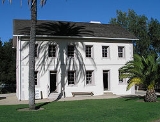
Rancho Los Encinos
Encyclopedia
Rancho Los Encinos was a Spanish
grazing concession, and later Mexican land grant
ed cattle
and sheep ranch
o and travelers way-station on the El Camino Real
in the San Fernando Valley
, in present day Encino
, Los Angeles County
, California
. The original 19th century adobe
and limestone
structures and natural warm springs are now within the Los Encinos State Historic Park
.
of 1769: El Valle de Santa Catalina de Bononia de los Encinos, with encino being the Spanish
name for Oak
s, after the many native deciduus Valley Oak (Quercus lobata) and evergreen Coast Live Oak (Quercus agrifolia) trees across the valley's savannah
, which are still found on the park's property.
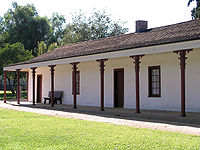 Francisco Reyes
Francisco Reyes
, Alcalde
, or mayor of Pueblo de Los Angeles
from 1793-1795, established the original Rancho Encino in the northern San Fernando Valley. In or around 1797 Reyes ceded this land to the Roman Catholic Church
to be the site of Mission San Fernando Rey de España
, and relocated his Rancho Encino to one square league (4,460 acres) of land in the southern valley adjacent to El Camino Real and between the Los Angeles River
and Santa Monica Mountains
.
Reyes was accused of mistreating the Mission Indians
who worked his rancho, and in 1845 Mexican Governor Pio Pico
re-granted the property to three of the Tongva Native American
workers, recorded as Ramon, Francisco, and Roque, who raised cattle and corn on their regained land.
In 1849, Don Vicente de la Osa or de la Ossa, the original owner of the nearby Rancho Providencia
, acquired the Tongva Indian's interests in the property. His wife was Rita de Guillén de la Ossa, daughter of Eulalia Pérez de Guillén Mariné
of Rancho San Pascual
. He built a 9-room adobe farmhouse in 1849-1850 that still stands near the spring. He took formal title to the Rancho under U.S. California law in 1851.
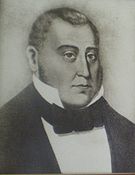 The California Gold Rush
The California Gold Rush
of 1849 created a near-insatiable demand for beef, which was raised on the ranchos of southern California, including Rancho Los Encinos, and driven on the hoof to northern markets serving the gold fields. But the boom market in Southern California began to decline as early as 1855 as it became profitable to drive cattle and sheep to California from the midwest and Texas
, and the drought
of 1856 increased the pressure on the ranchos.
The De La Osa rancho was a popular stopping point for El Camino Real
and Camino Nuevo
travelers, who could expect hospitality at the ranch house. The Butterfield Overland Mail
stagecoach route between St. Louis, Missouri
and San Francisco via Fort Yuma
and Los Angeles
passed through the rancho, making its first run in the fall of 1858. A new stagecoach route opened in 1861, diverging from the old El Camino Real at Rancho Los Encinos and heading for Santa Barbara
via the Santa Susana Stage Road over Santa Susana Pass
in the Simi Hills
. The rancho was a stagecoach
stop on it until the new railroad replaced Butterfield stages in 1875.
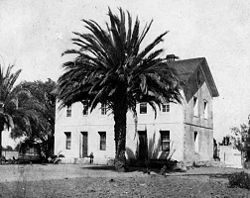 With the cattle market in collapse and besieged by mounting debts, in 1859 De la Osa converted his house into a roadside inn and began to charge patrons for his legendary Californio
With the cattle market in collapse and besieged by mounting debts, in 1859 De la Osa converted his house into a roadside inn and began to charge patrons for his legendary Californio
hospitality. Don Vicente De la Osa died in 1861, and his widow Rita sold the property to James Thompson in 1867, who raised sheep on the rancho for two years. Thompson in turn sold the property to two Basque
brothers, Eugene and Phillipe Garnier, in 1869. Eugene Garnier built a two-story limestone farmhouse similar to the former family home in the French
Basque Country
, and a brick-lined pond
collecting the spring's outflow and shaped like a Spanish guitar
. The Garnier brothers also raised sheep on the property, and were known for the fine quality of their fleece
, but they in turn became overextended and lost the property to foreclosure in 1878.
The property changed hands three times in the next twenty years, eventually being acquired entire by Domingo Amestoy
in 1889. The fields were used for wheat
farm
ing, as was most of the Valley after Isaac Newton Van Nuys
introduced dryland farming
there. The Amestoy family lived on the property until 1945, selling off 1170 acres (5 km²) of land in 1916 that would become the community of Encino, and further subdividing the ranchlands thereafter.
The last remaining parcel, including the historic buildings and the spring
, was acquired by the state of California in 1949.
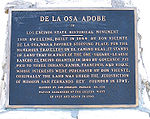
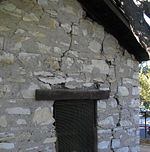 All of the historic buildings in the park were heavily damaged in the 1994 Northridge earthquake
All of the historic buildings in the park were heavily damaged in the 1994 Northridge earthquake
. The De la Osa adobe and the stone Garnier building have been repaired and restored, with the Garnier building now serving as a visitor center with historic photographs and exhibits of the rancho's past. The Los Encinos Photos archives are also online. The 1902 river stones and mortar walled, double-roofed, food-cool storage buildings built for the Amestoys still show signs of the earthquake and are used for Park storage.
A major Tongva village or rancheria
site, carbon-date
d at over 3,000 years old, was discovered in 1984 directly across Ventura Boulevard during excavation for a new structure. Archeologists found two million artifacts, such as lithic
stone tools, shel and stone bead
s, and arrowhead
s, and ancient burial remains. The park displays some of the pre-contact artifacts.
The park is located at 16756 Moorpark Street, Encino, California, 91436-1068, and is open to the public 10 AM to 5 PM, Wednesday through Sunday. There is a pedestrian entrance on Ventura Boulevard.
Spain
Spain , officially the Kingdom of Spain languages]] under the European Charter for Regional or Minority Languages. In each of these, Spain's official name is as follows:;;;;;;), is a country and member state of the European Union located in southwestern Europe on the Iberian Peninsula...
grazing concession, and later Mexican land grant
Ranchos of California
The Spanish, and later the Méxican government encouraged settlement of territory now known as California by the establishment of large land grants called ranchos, from which the English ranch is derived. Devoted to raising cattle and sheep, the owners of the ranchos attempted to pattern themselves...
ed cattle
Cattle
Cattle are the most common type of large domesticated ungulates. They are a prominent modern member of the subfamily Bovinae, are the most widespread species of the genus Bos, and are most commonly classified collectively as Bos primigenius...
and sheep ranch
Ranch
A ranch is an area of landscape, including various structures, given primarily to the practice of ranching, the practice of raising grazing livestock such as cattle or sheep for meat or wool. The word most often applies to livestock-raising operations in the western United States and Canada, though...
o and travelers way-station on the El Camino Real
El Camino Real (California)
El Camino Real and sometimes associated with Calle Real usually refers to the 600-mile California Mission Trail, connecting the former Alta California's 21 missions , 4 presidios, and several pueblos, stretching from Mission San Diego de Alcalá in San Diego...
in the San Fernando Valley
San Fernando Valley
The San Fernando Valley is an urbanized valley located in the Los Angeles metropolitan area of southern California, United States, defined by the dramatic mountains of the Transverse Ranges circling it...
, in present day Encino
Encino, Los Angeles, California
Encino is a hilly district of the city of Los Angeles, California, United States. Specifically, it is located in the central portion of the southern San Fernando Valley and on the north slope of the Santa Monica Mountains...
, Los Angeles County
Los Angeles County, California
Los Angeles County is a county in the U.S. state of California. As of 2010 U.S. Census, the county had a population of 9,818,605, making it the most populous county in the United States. Los Angeles County alone is more populous than 42 individual U.S. states...
, California
California
California is a state located on the West Coast of the United States. It is by far the most populous U.S. state, and the third-largest by land area...
. The original 19th century adobe
Adobe
Adobe is a natural building material made from sand, clay, water, and some kind of fibrous or organic material , which the builders shape into bricks using frames and dry in the sun. Adobe buildings are similar to cob and mudbrick buildings. Adobe structures are extremely durable, and account for...
and limestone
Limestone
Limestone is a sedimentary rock composed largely of the minerals calcite and aragonite, which are different crystal forms of calcium carbonate . Many limestones are composed from skeletal fragments of marine organisms such as coral or foraminifera....
structures and natural warm springs are now within the Los Encinos State Historic Park
Los Encinos State Historic Park
Los Encinos State Historic Park is located near the corner of Balboa and Ventura Blvd. in Encino, California. It was the hub of Rancho Los Encinos...
.
Origins
The name of the rancho derives from the original designation of the Valley by the Portola expeditionPortola expedition
250px|right|Point of San Francisco Bay DiscoveryThe Portolá Expedition was led by Gaspar de Portolá from July 14, 1769 to January 24, 1770. It was the first recorded Spanish land entry and exploration of present day California, United States...
of 1769: El Valle de Santa Catalina de Bononia de los Encinos, with encino being the Spanish
Spanish language
Spanish , also known as Castilian , is a Romance language in the Ibero-Romance group that evolved from several languages and dialects in central-northern Iberia around the 9th century and gradually spread with the expansion of the Kingdom of Castile into central and southern Iberia during the...
name for Oak
Oak
An oak is a tree or shrub in the genus Quercus , of which about 600 species exist. "Oak" may also appear in the names of species in related genera, notably Lithocarpus...
s, after the many native deciduus Valley Oak (Quercus lobata) and evergreen Coast Live Oak (Quercus agrifolia) trees across the valley's savannah
Savannah
Savannah or savanna is a type of grassland.It can also mean:-People:* Savannah King, a Canadian freestyle swimmer* Savannah Outen, a singer who gained popularity on You Tube...
, which are still found on the park's property.

Juan Francisco Reyes (soldier)
Juan Francisco Reyes , soldado de cuero on the 1769 Portola expedition, alcalde of the Pueblo de Los Angeles for three terms, and recipient of the Spanish land grant for Los Encino and later Lompoc.-Juan Francisco Reyes:In 1769 Francisco Reyes, left his home in Mexico to join the Spanish army...
, Alcalde
Alcalde
Alcalde , or Alcalde ordinario, is the traditional Spanish municipal magistrate, who had both judicial and administrative functions. An alcalde was, in the absence of a corregidor, the presiding officer of the Castilian cabildo and judge of first instance of a town...
, or mayor of Pueblo de Los Angeles
Pueblo de Los Angeles
El Pueblo de Nuestra Señora la Reina de los Ángeles was the Spanish civilian pueblo founded in 1781, which by the 20th century became the American metropolis of Los Angeles....
from 1793-1795, established the original Rancho Encino in the northern San Fernando Valley. In or around 1797 Reyes ceded this land to the Roman Catholic Church
Roman Catholic Church
The Catholic Church, also known as the Roman Catholic Church, is the world's largest Christian church, with over a billion members. Led by the Pope, it defines its mission as spreading the gospel of Jesus Christ, administering the sacraments and exercising charity...
to be the site of Mission San Fernando Rey de España
Mission San Fernando Rey de España
Mission San Fernando Rey de España was founded on "The Feast of the Birth of Mary" , 1797. The settlement is located on the former Encino Rancho in the Mission Hills community of northern Los Angeles, near the site of the first gold discovery in Alta California.-History:Mission San Fernando Rey de...
, and relocated his Rancho Encino to one square league (4,460 acres) of land in the southern valley adjacent to El Camino Real and between the Los Angeles River
Los Angeles River
The Los Angeles River is a river that starts in the San Fernando Valley, in the Simi Hills and Santa Susana Mountains, and flows through Los Angeles County, California, from Canoga Park in the western end of the San Fernando Valley, nearly southeast to its mouth in Long Beach...
and Santa Monica Mountains
Santa Monica Mountains
The Santa Monica Mountains are a Transverse Range in Southern California, along the coast of the Pacific Ocean in the United States.-Geography:...
.
Reyes was accused of mistreating the Mission Indians
Mission Indians
Mission Indians is a term for many Native California tribes, primarily living in coastal plains, adjacent inland valleys and mountains, and on the Channel Islands in central and southern California, United States. The tribes had established comparatively peaceful cultures varying from 250 to 8,000...
who worked his rancho, and in 1845 Mexican Governor Pio Pico
Pío Pico
Pío de Jesús Pico was the last Governor of Alta California under Mexican rule.-Origins:...
re-granted the property to three of the Tongva Native American
Native Americans in the United States
Native Americans in the United States are the indigenous peoples in North America within the boundaries of the present-day continental United States, parts of Alaska, and the island state of Hawaii. They are composed of numerous, distinct tribes, states, and ethnic groups, many of which survive as...
workers, recorded as Ramon, Francisco, and Roque, who raised cattle and corn on their regained land.
In 1849, Don Vicente de la Osa or de la Ossa, the original owner of the nearby Rancho Providencia
Rancho Providencia
Rancho La Providencia was a Mexican land grant in present day Los Angeles County, California given by governor Juan B. Alvarado in 1843 to Vincente de la Osa. The majority of Rancho Providencia land north of the modern channel of the Los Angeles River is now part of Burbank. The street grid...
, acquired the Tongva Indian's interests in the property. His wife was Rita de Guillén de la Ossa, daughter of Eulalia Pérez de Guillén Mariné
Eulalia Perez de Guillén Mariné
Eulalia Pérez de Guillén Mariné was a Californio who was mayordoma of Missión San Gabriel Arcángel and grantee of Rancho del Rincón de San Pascual in the San Rafael Hills, in present day Los Angeles County, California...
of Rancho San Pascual
Rancho San Pascual
Rancho San Pascual also known as Rancho el Rincon de San Pascual was a Mexican land grant in present day Los Angeles County, California given to Juan Marine in 1834 by José Figueroa...
. He built a 9-room adobe farmhouse in 1849-1850 that still stands near the spring. He took formal title to the Rancho under U.S. California law in 1851.
Boom and bust

California Gold Rush
The California Gold Rush began on January 24, 1848, when gold was found by James W. Marshall at Sutter's Mill in Coloma, California. The first to hear confirmed information of the gold rush were the people in Oregon, the Sandwich Islands , and Latin America, who were the first to start flocking to...
of 1849 created a near-insatiable demand for beef, which was raised on the ranchos of southern California, including Rancho Los Encinos, and driven on the hoof to northern markets serving the gold fields. But the boom market in Southern California began to decline as early as 1855 as it became profitable to drive cattle and sheep to California from the midwest and Texas
Texas
Texas is the second largest U.S. state by both area and population, and the largest state by area in the contiguous United States.The name, based on the Caddo word "Tejas" meaning "friends" or "allies", was applied by the Spanish to the Caddo themselves and to the region of their settlement in...
, and the drought
Drought
A drought is an extended period of months or years when a region notes a deficiency in its water supply. Generally, this occurs when a region receives consistently below average precipitation. It can have a substantial impact on the ecosystem and agriculture of the affected region...
of 1856 increased the pressure on the ranchos.
The De La Osa rancho was a popular stopping point for El Camino Real
El Camino Real
El Camino Real The name may mean:-Roads:* El Camino Real , also known as the California Mission Trail, linked California's Spanish missions, sub-missions , stations , towns , and forts and El Camino went from east texas...
and Camino Nuevo
Camino nuevo
Camino Nuevo is a Spanish phrase meaning "New Highway." The term is used in shorthand for several facilities:*Camino Nuevo High School*Camino Nuevo Correctional Center, Albuquerque NM...
travelers, who could expect hospitality at the ranch house. The Butterfield Overland Mail
Butterfield Overland Mail
The Butterfield Overland Mail Trail was a stagecoach route in the United States, operating from 1857 to 1861. It was a conduit for the U.S. mail from two eastern termini, Memphis, Tennessee and St. Louis, Missouri, meeting Fort Smith, Arkansas, and continuing through Indian Territory, New Mexico,...
stagecoach route between St. Louis, Missouri
St. Louis, Missouri
St. Louis is an independent city on the eastern border of Missouri, United States. With a population of 319,294, it was the 58th-largest U.S. city at the 2010 U.S. Census. The Greater St...
and San Francisco via Fort Yuma
Fort Yuma
Fort Yuma is a fort in California that is located in Imperial County, across the Colorado River from Yuma, Arizona. It was on the Butterfield Overland Mail route from 1858 until 1861 and was abandoned May 16, 1883, and transferred to the Department of the Interior. The Fort Yuma Indian School and a...
and Los Angeles
Los Ángeles
Los Ángeles is the capital of the province of Biobío, in the commune of the same name, in Region VIII , in the center-south of Chile. It is located between the Laja and Biobío rivers. The population is 123,445 inhabitants...
passed through the rancho, making its first run in the fall of 1858. A new stagecoach route opened in 1861, diverging from the old El Camino Real at Rancho Los Encinos and heading for Santa Barbara
Santa Barbara, California
Santa Barbara is the county seat of Santa Barbara County, California, United States. Situated on an east-west trending section of coastline, the longest such section on the West Coast of the United States, the city lies between the steeply-rising Santa Ynez Mountains and the Pacific Ocean...
via the Santa Susana Stage Road over Santa Susana Pass
Santa Susana Pass
The Santa Susana Pass is a Southern California mountain pass in the Simi Hills connecting the San Fernando Valley and town of Chatsworth, to the Simi Valley and city of Simi Valley.-Natural history:...
in the Simi Hills
Simi Hills
The Simi Hills are a low rocky mountain range of the Transverse Ranges, located in eastern Ventura County and western Los Angeles County, of southern California, United States.-Geography:...
. The rancho was a stagecoach
Stagecoach
A stagecoach is a type of covered wagon for passengers and goods, strongly sprung and drawn by four horses, usually four-in-hand. Widely used before the introduction of railway transport, it made regular trips between stages or stations, which were places of rest provided for stagecoach travelers...
stop on it until the new railroad replaced Butterfield stages in 1875.

Californio
Californio is a term used to identify a Spanish-speaking Catholic people, regardless of race, born in California before 1848...
hospitality. Don Vicente De la Osa died in 1861, and his widow Rita sold the property to James Thompson in 1867, who raised sheep on the rancho for two years. Thompson in turn sold the property to two Basque
Basque people
The Basques as an ethnic group, primarily inhabit an area traditionally known as the Basque Country , a region that is located around the western end of the Pyrenees on the coast of the Bay of Biscay and straddles parts of north-central Spain and south-western France.The Basques are known in the...
brothers, Eugene and Phillipe Garnier, in 1869. Eugene Garnier built a two-story limestone farmhouse similar to the former family home in the French
France
The French Republic , The French Republic , The French Republic , (commonly known as France , is a unitary semi-presidential republic in Western Europe with several overseas territories and islands located on other continents and in the Indian, Pacific, and Atlantic oceans. Metropolitan France...
Basque Country
Northern Basque Country
The French Basque Country or Northern Basque Country situated within the western part of the French department of the Pyrénées-Atlantiques constitutes the north-eastern part of the Basque Country....
, and a brick-lined pond
Pond
A pond is a body of standing water, either natural or man-made, that is usually smaller than a lake. A wide variety of man-made bodies of water are classified as ponds, including water gardens, water features and koi ponds; all designed for aesthetic ornamentation as landscape or architectural...
collecting the spring's outflow and shaped like a Spanish guitar
Classical guitar
The classical guitar is a 6-stringed plucked string instrument from the family of instruments called chordophones...
. The Garnier brothers also raised sheep on the property, and were known for the fine quality of their fleece
Wool
Wool is the textile fiber obtained from sheep and certain other animals, including cashmere from goats, mohair from goats, qiviut from muskoxen, vicuña, alpaca, camel from animals in the camel family, and angora from rabbits....
, but they in turn became overextended and lost the property to foreclosure in 1878.
The property changed hands three times in the next twenty years, eventually being acquired entire by Domingo Amestoy
Dominique Amestoy
Domingo Amestoy was a Basque sheepherder, and banker, one of the original founders to provide the financing for the Farmers and Merchants Bank in Los Angeles, California, in 1871.-Life:...
in 1889. The fields were used for wheat
Wheat
Wheat is a cereal grain, originally from the Levant region of the Near East, but now cultivated worldwide. In 2007 world production of wheat was 607 million tons, making it the third most-produced cereal after maize and rice...
farm
Farm
A farm is an area of land, or, for aquaculture, lake, river or sea, including various structures, devoted primarily to the practice of producing and managing food , fibres and, increasingly, fuel. It is the basic production facility in food production. Farms may be owned and operated by a single...
ing, as was most of the Valley after Isaac Newton Van Nuys
Isaac Newton Van Nuys
Isaac Newton Van Nuys was an American businessman, real estate developer, banker, and agricultural entrepreneur. He founded the community of Van Nuys in the San Fernando Valley of Southern California in 1911...
introduced dryland farming
Dryland farming
Dryland farming is an agricultural technique for non-irrigated cultivation of drylands.-Locations:Dryland farming is used in the Great Plains, the Palouse plateau of Eastern Washington, and other arid regions of North America, the Middle East and in other grain growing regions such as the steppes...
there. The Amestoy family lived on the property until 1945, selling off 1170 acres (5 km²) of land in 1916 that would become the community of Encino, and further subdividing the ranchlands thereafter.
The last remaining parcel, including the historic buildings and the spring
Spring (hydrosphere)
A spring—also known as a rising or resurgence—is a component of the hydrosphere. Specifically, it is any natural situation where water flows to the surface of the earth from underground...
, was acquired by the state of California in 1949.
Los Encinos State Historic Park


Northridge earthquake
The Northridge earthquake was a massive earthquake that occurred on January 17, 1994, at 04:31 Pacific Standard Time in Reseda, a neighborhood in the city of Los Angeles, California, lasting for about 10–20 seconds...
. The De la Osa adobe and the stone Garnier building have been repaired and restored, with the Garnier building now serving as a visitor center with historic photographs and exhibits of the rancho's past. The Los Encinos Photos archives are also online. The 1902 river stones and mortar walled, double-roofed, food-cool storage buildings built for the Amestoys still show signs of the earthquake and are used for Park storage.
A major Tongva village or rancheria
Ranchería
The Spanish word ranchería, or rancherío, refers to a small, rural settlement. In the Americas the term was applied to native villages and to the workers' quarters of a ranch. English adopted the term with both these meanings, usually to designate the residential area of a rancho in the American...
site, carbon-date
Radiocarbon dating
Radiocarbon dating is a radiometric dating method that uses the naturally occurring radioisotope carbon-14 to estimate the age of carbon-bearing materials up to about 58,000 to 62,000 years. Raw, i.e. uncalibrated, radiocarbon ages are usually reported in radiocarbon years "Before Present" ,...
d at over 3,000 years old, was discovered in 1984 directly across Ventura Boulevard during excavation for a new structure. Archeologists found two million artifacts, such as lithic
Stone tool
A stone tool is, in the most general sense, any tool made either partially or entirely out of stone. Although stone tool-dependent societies and cultures still exist today, most stone tools are associated with prehistoric, particularly Stone Age cultures that have become extinct...
stone tools, shel and stone bead
Bead
A bead is a small, decorative object that is usually pierced for threading or stringing. Beads range in size from under to over in diameter. A pair of beads made from Nassarius sea snail shells, approximately 100,000 years old, are thought to be the earliest known examples of jewellery. Beadwork...
s, and arrowhead
Arrowhead
An arrowhead is a tip, usually sharpened, added to an arrow to make it more deadly or to fulfill some special purpose. Historically arrowheads were made of stone and of organic materials; as human civilization progressed other materials were used...
s, and ancient burial remains. The park displays some of the pre-contact artifacts.
The park is located at 16756 Moorpark Street, Encino, California, 91436-1068, and is open to the public 10 AM to 5 PM, Wednesday through Sunday. There is a pedestrian entrance on Ventura Boulevard.
See also
- Ranchos of CaliforniaRanchos of CaliforniaThe Spanish, and later the Méxican government encouraged settlement of territory now known as California by the establishment of large land grants called ranchos, from which the English ranch is derived. Devoted to raising cattle and sheep, the owners of the ranchos attempted to pattern themselves...
- List of Ranchos of California
- History of the San Fernando Valley to 1915History of the San Fernando Valley to 1915The history of the San Fernando Valley from its exploration by the 1769 Portola expedition to the annexation of much of it by the City of Los Angeles in 1915 is a story of booms and busts, as cattle ranching, sheep ranching, large-scale wheat farming, and fruit orchards flourished and faded...
- List of Los Angeles Historic-Cultural Monuments in the San Fernando Valley
- National Register of Historic Places listings in Los Angeles, California
- National Register of Historic Places listings in Los Angeles County, California
- History of Los Angeles, CaliforniaHistory of Los Angeles, CaliforniaLos Angeles changed rapidly after 1848, when California was transferred to the United States as a result of the Treaty of Guadalupe Hidalgo that ended the Mexican-American War...

